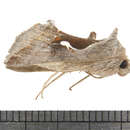Conservation Status
provided by University of Alberta Museums
A common, widespread species; no concerns.
- license
- cc-by-nc
- copyright
- University of Alberta Museums
Cyclicity
provided by University of Alberta Museums
Adults have been collected in Alberta from mid-May through early September.
- license
- cc-by-nc
- copyright
- University of Alberta Museums
Distribution
provided by University of Alberta Museums
Newfoundland and Labrador west across southern Canada to central British Columbia, south to northern California, Arizona and Texas. It has been found throughout the southern half of Alberta, north in the cultivated parts of the southern Boreal forest and Foothills regions to the Nordegg, Edmonton and Ashmont areas.
- license
- cc-by-nc
- copyright
- University of Alberta Museums
General Description
provided by University of Alberta Museums
A medium-size (3.5-4.0 cm wingspan) moth with two color-forms, dark-brown or grey. The grey form, most common early in the season, is light grey with little mottling, shading to dark brown in the lower half of the forewing, between the antemedian and postmedian lines and in a band from the apex to the outer lower margin. The brown form is dark red-brown over most of the forewing except for a paler grey brown area at the wing base and along the outer margin. Stigma is a curved silver bar, rounded on the outer end, with a short spur on the upper arm. The lower arm continues as the lower half of the antemedian line. Hindwings in both forms are light red-brown, with a distinct narrow postmedian band and shading to a wide dark terminal band. The antennae are simple and boht the sexes are alike.
- license
- cc-by-nc
- copyright
- University of Alberta Museums
Habitat
provided by University of Alberta Museums
Open areas, including roadsides, meadows, pastures, gardens, cropland, bogs etc.
- license
- cc-by-nc
- copyright
- University of Alberta Museums
Life Cycle
provided by University of Alberta Museums
The adults are active during both day and at night, and are attracted to light.
- license
- cc-by-nc
- copyright
- University of Alberta Museums
Trophic Strategy
provided by University of Alberta Museums
No Alberta data. Elsewhere the larvae are known to feed on a wide variety of herbaceous plants as well as a few shrubs. In some areas south and east of Alberta, it is a serious pest on cultivated crops such as beets, celery, corn, lettuce, cabbage, carrots and blueberry. Reported non-cultivated hosts include plantain, clover, and Viburnum.
- license
- cc-by-nc
- copyright
- University of Alberta Museums
Anagrapha falcifera
provided by wikipedia EN
Anagrapha falcifera, the celery looper, is a moth of the family Noctuidae. The species was first described by William Kirby in 1837. It is found in North America from Newfoundland, Labrador and southern Canada to Georgia, Mississippi, Texas, Arizona, Idaho, Washington and Oregon.

Adult on leaf, showing the great camouflage
The wingspan is 35–40 mm.
The larvae feed on beets, blueberries, clover, corn, lettuce, plantain, viburnum and other low plants.

- license
- cc-by-sa-3.0
- copyright
- Wikipedia authors and editors
Anagrapha falcifera: Brief Summary
provided by wikipedia EN
Anagrapha falcifera, the celery looper, is a moth of the family Noctuidae. The species was first described by William Kirby in 1837. It is found in North America from Newfoundland, Labrador and southern Canada to Georgia, Mississippi, Texas, Arizona, Idaho, Washington and Oregon.

Adult on leaf, showing the great camouflage
The wingspan is 35–40 mm.
The larvae feed on beets, blueberries, clover, corn, lettuce, plantain, viburnum and other low plants.
- license
- cc-by-sa-3.0
- copyright
- Wikipedia authors and editors


 Adult on leaf, showing the great camouflage
Adult on leaf, showing the great camouflage